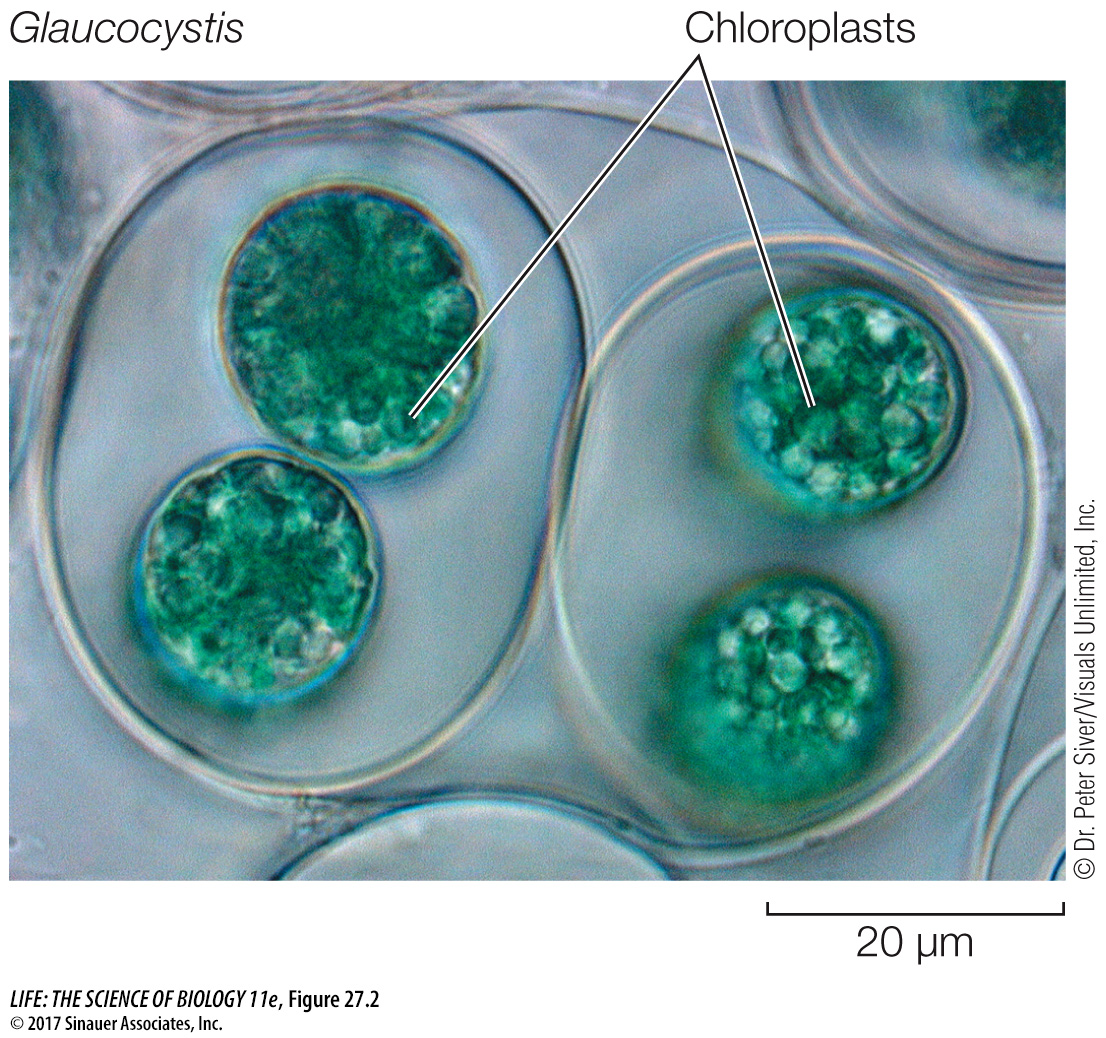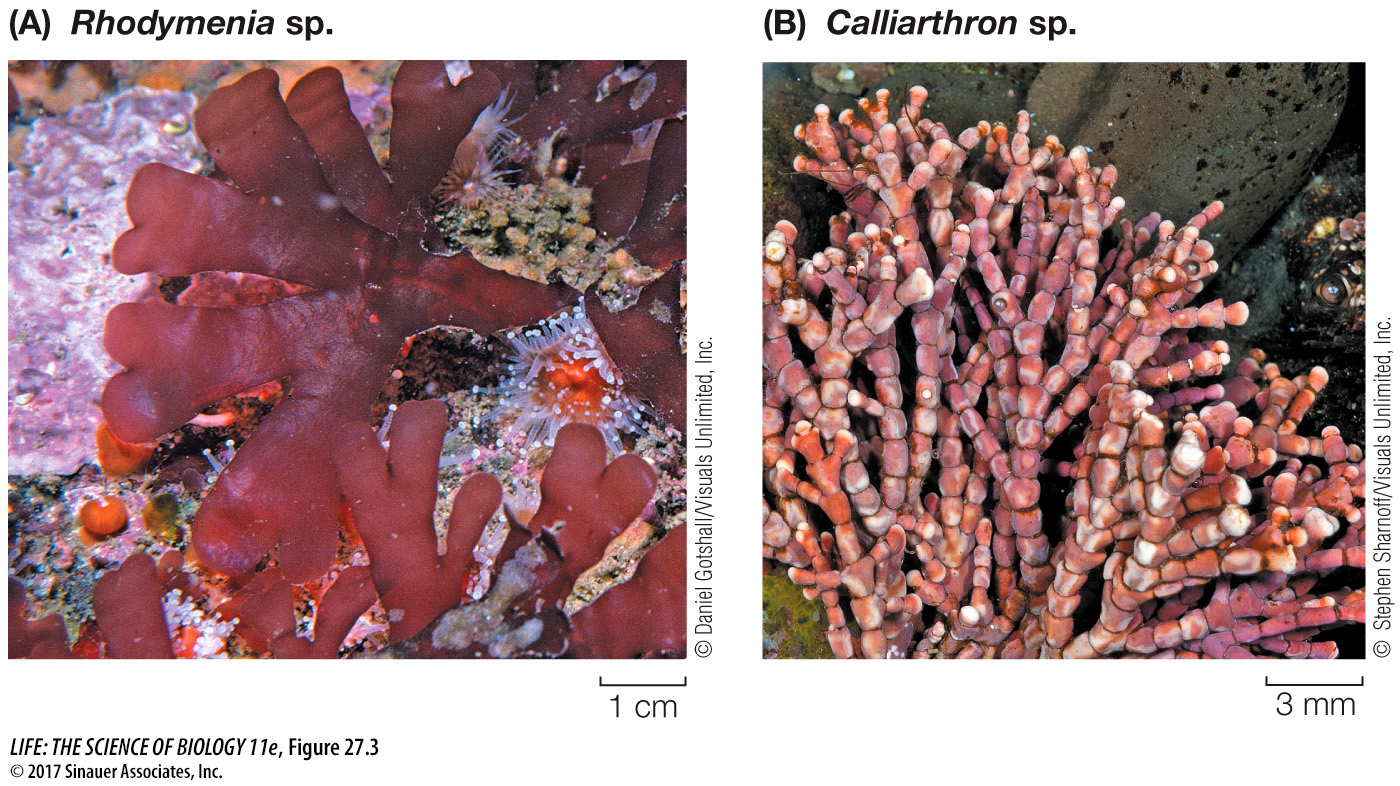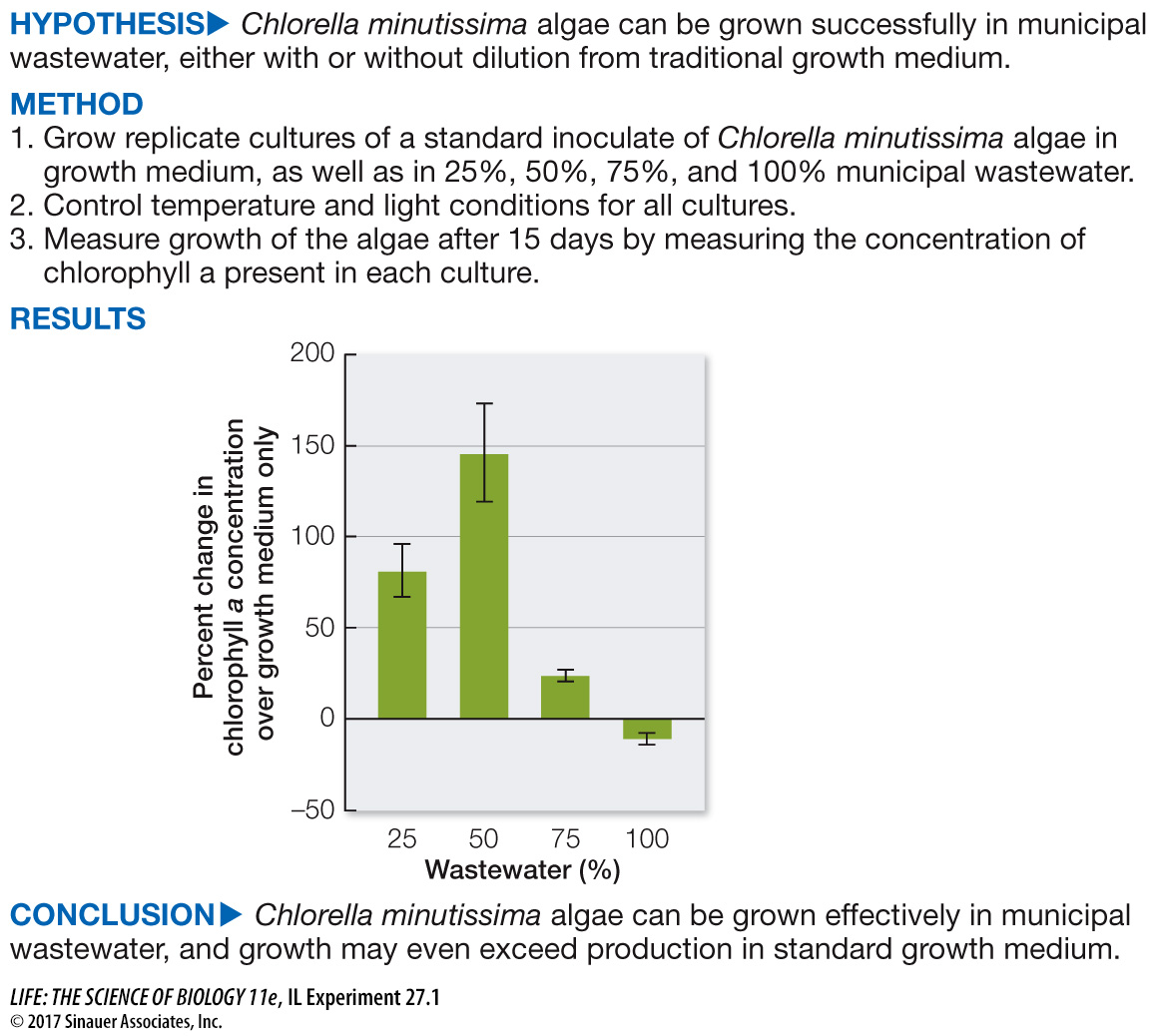Several distinct clades of algae were among the first photosynthetic eukaryotes
The ancestor of Plantae was unicellular and may have been similar in general form to the modern glaucophytes (Figure 27.2). These microscopic freshwater algae are thought to be the sister group of the rest of Plantae (see Figure 27.1A). The chloroplast of glaucophytes is unique in containing a small amount of peptidoglycan between its inner and outer membranes—

In contrast to the glaucophytes, almost all red algae are multicellular (Figure 27.3). Their characteristic color is a result of the accessory photosynthetic pigment phycoerythrin, which is found in relatively large amounts in the chloroplasts of many red algae. In addition to phycoerythrin, red algal chloroplasts contain chlorophyll a as well as several other accessory pigments.

The red algae include species that grow in the shallowest tide pools as well as the photosynthesizers found deepest in the ocean (as deep as 260 m if nutrient conditions are right and the water is clear enough to permit light to penetrate). A few red algae inhabit fresh water. Most grow attached to a substrate by a holdfast.
575
Despite their name, red algae don’t always appear red in color. The ratio of two pigments—
The remaining algal groups in Plantae are the various “green algae.” Like land plants, the green algae contain both chlorophylls a and b and store their reserve of photosynthetic products as starch in chloroplasts. All the groups that share these features are commonly called green plants because both of their photosynthetic pigments are green.
The largest clade of “green algae” is the chlorophytes. There are more than 17,000 species of chlorophytes, most of which are aquatic (some are marine, though more are freshwater forms), although there are a few terrestrial forms that live in moist environments. Chlorophytes range in size from microscopic unicellular forms to multicellular forms many centimeters long and display an incredible variety of shapes and body forms. Surprisingly large and well-

Volvox is a colonial unicellular chlorophyte, but there are also many true multicellular species of chlorophytes. Some of these are filamentous. Others, like species in the genus Ulva (Figure 27.4B), grow into thin, membranous sheets up to 30 centimeters in width.
576
investigating life
Can Chlorella Algae Be Grown in Municipal Sewage Wastewater for Biofuel Production?
experiment
Original Paper: Bhatnagar, A., M. Bhatnagar, S. Chinnasamy and K. C. Das. 2010. Chlorella minutissima—A promising fuel alga for cultivation in municipal wastewaters. Applied Biochemistry and Biotechnology 161: 523–
Growing algae for use in biofuel production requires an abundant source of freshwater that contains appropriate nutrients. Appropriate nutrients for growing algae are present in municipal wastewater, but other contaminants of wastewater (such as salts and detergents) could diminish algal growth. Ashish Bhatnagar and his colleagues at the University of Georgia conducted an experiment to see if Chlorella minutissima algae could be grown successfully in municipal wastewater.

Question
Q: At what tested concentration of wastewater does the algae grow the best?
The algae grow best in 50% wastewater and 50% growth medium.
work with the data
After determining that municipal wastewater could be used to grow Chlorella minutissima for biofuel production, Ashish Bhatnagar and his colleagues explored the effects on Chlorella growth of various sources of carbon that were present in the wastewater. The table below shows three measures of algal growth in standard growth medium, as well as in the medium with added sources of carbon. Use these data to answer the following questions.
QUESTIONS
Question 1
Calculate 95% confidence intervals for mean measures of chlorophyll a concentration in the various growth media (see Appendix B for directions on calculating confidence intervals from standard errors). Which carbon source additives result in significantly higher or lower chlorophyll a concentrations (based on non-
The 95% confidence intervals for the means can be calculated by multiplying the standard errors of the means by 1.96, and then adding and subtracting this product from the respective mean.
The 95% confidence limits for each measure of chlorophyll a concentration (mg/L) in the various growth media are as follows:
| Growth medium only | Growth medium + propionate |
Growth medium + acetate |
Growth medium + citrate |
Growth medium + sucrose |
Growth medium + glucose |
|---|---|---|---|---|---|
| 10.98– 15.84 | 1.66–1.78 | 7.79–11.01 | 14.10– 16.42 | 15.94– 19.32 | 29.84– 44.58 |
Chlorophyll a concentrations in growth medium + propionate are clearly lower than in growth medium alone, as the 95% confidence intervals do not overlap. There is almost no overlap between the growth medium only and growth medium + acetate conditions, with the added acetate showing lower chlorophyll a concentrations. There is substantial overlap in the confidence intervals for growth medium alone and growth medium + citrate, suggesting no significant difference in those two conditions. The other two conditions, with sucrose or glucose added to the growth medium, result in significantly higher chlorophyll a concentrations than does growth medium alone.
Question 2
Plot the measures for chlorophyll a concentration, biomass, and cell count for each growth condition. Which two measures appear to be most strongly correlated? Can you think of reasons why the uncorrelated measure might show a different trend than the two correlated measures?

The measures of chlorophyll a concentration and biomass are strongly correlated, whereas cell counts are not as strongly correlated with these other measures. The reason is that favorable growth conditions produce large cells (with greater biomass) that contain proportionally more chlorophyll a, whereas poor growth conditions produce small cells that contain proportionally less chlorophyll a. Although poor growth conditions sometimes result in fewer cells than favorable growth conditions, the growth conditions have a greater effect on cell size than on cell numbers.
| Measurementa | Growth medium only | Growth medium + propionate |
Growth medium + acetate |
Growth medium + citrate |
Growth medium + sucrose |
Growth medium + glucose |
|---|---|---|---|---|---|---|
| Chlorophyll a concentration (mg/L) | 13.41 | 1.72 | 9.4 | 15.26 | 17.63 | 37.21 |
| (1.24) | (0.03) | (0.82) | (0.59) | (0.86) | (3.76) | |
| Biomass (mg/L) | 899 | 120 | 630 | 1,007 | 1,164 | 2,456 |
| (27.6) | (12.6) | (35.1) | (110.4) | (87.9) | (297.7) | |
| Cell count (per 10–5 mL) | 2.01 | 0.51 | 1.89 | 1.50 | 1.93 | 1.76 |
| (0.17) | (0.02) | (0.08) | (0.07) | (0.17) | (0.18) |
a Measures are means, with standard errors of mean shown in parentheses.
A similar work with the data exercise may be assigned in LaunchPad.
577
Biologists are exploring mass production of several species of chlorophytes as a source of biofuels. One of the biggest limitations in using algae for biofuels relates to the cost of providing an appropriate growth medium for the algae. Growth media typically require fresh water and abundant sources of carbon, nitrogen, and phosphorus. These nutrients are already present in most municipal wasterwater supplies, and the removal of these nutrients by growing algae would help clean the water supply. Investigating Life: Can Chlorella Algae Be Grown in Municipal Sewage Wastewater for Biofuel Production? explores the poential of municipal wasterwater as a growth medium for algae used in biofuel production.